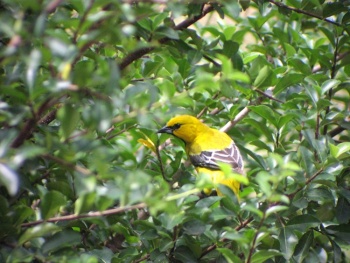Disambiguation: The name Yellow Oriole or Australian Yellow Oriole is sometimes used for Green Oriole
- Icterus nigrogularis
Identification
20–21 cm (7¾-8¼ in)
Male
- Yellow plumage
- Black wings
- Black eye mask
- narrow black throat line
- Black tail
- White wing bar
The female is similar but duller
Juvenile has an olive-tinged yellow back, and no black on the face.
Distribution
Northern South America in Colombia, Venezuela, Trinidad, the Guianas and northern Brazil.
Taxonomy
Subspecies
There are four subspecies[1] of which three are restricted to islands. They differ from the widespread nominate race of the mainland in body and bill size, and minor plumage details.
- I. n. nigrogularis:
- I. n. curasoensis;
- Netherlands Antilles (Aruba, Curaçao and Bonaire)
- I. n. helioeides:
- Isla Margarita (off northern Venezuela)
- I. n. trinitatis:
- Nort-eastern Venezuela (eastern Paria Peninsula); Trinidad and Monos Island
Habitat
Dry and semi-arid open woodland, scrub and gardens.
Behaviour
Breeding
The nest is a 40 cm long hanging basket, which is suspended from the end of a branch. The normal clutch is three pale green or grey eggs.
Diet
The diet consists mainly of large insects, but will also eat nectar and some fruit.
Vocalisation
Song: a tuneful fluting, with some buzzing.
Calls: a cat-like whine, and chattering noises.
References
- Clements, J. F., T. S. Schulenberg, M. J. Iliff, D. Roberson, T. A. Fredericks, B. L. Sullivan, and C. L. Wood. 2015. The eBird/Clements checklist of birds of the world: v2015, with updates to August 2015. Downloaded from http://www.birds.cornell.edu/clementschecklist/download/
- Handbook of the Birds of the World Alive (retrieved November 2014)
- Wikipedia
Recommended Citation
- BirdForum Opus contributors. (2024) Yellow Oriole. In: BirdForum, the forum for wild birds and birding. Retrieved 18 April 2024 from https://www.birdforum.net/opus/Yellow_Oriole
External Links
GSearch checked for 2020 platform.1






